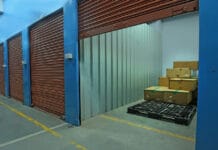Imagine you’re clearing out your garage for a big renovation or getting ready to move to a new place. You want to make sure everything is organized and safe, especially when it comes to hazardous materials. Here in this blog, we have suggested amazing methods for hazardous material storage to show you which items are okay to store and which ones are not. Think about paints, cleaners, and other stuff that might seem harmless but can be risky if stored improperly.
Through fun quizzes, interactive checklists, and easy-to-understand articles, we’ll guide you on a journey of safe storage practices. Here you can learn how to spot hazardous materials, how to store them safely, and why it’s important for your health and the environment.
Whether you’re a DIY enthusiast, a homeowner, or a business owner, this blog is your go-to resource for staying safe while decluttering, renovating, or relocating. So, buckle up and get ready to explore the world of hazardous materials storage engagingly!
Hazardous Materials Storage – An Overview
For maintaining safety, understanding hazardous materials is very important. It is often referred to as chemicals or hazardous substances, that can pose risks to safety, health and the environment if not handled properly. Common examples include paints, solvents, cleaners, pesticides, batteries, and certain electronic devices containing hazardous components like lead or mercury.
The proper storage of these materials is important to prevent any accidents such as leakage, spillage, fire or toxic exposures. Improper storage can also lead to environmental damage, contaminating soil, water sources, and air quality. Following the below-provided guidelines for packaging, labelling and storing these materials in a designated area, the risk can be minimized.
Hazardous Materials Storage – What’s Allowed in Storage Unit?
There are certain hazardous materials that are allowed under the compliance of regulatory guidelines. These materials often include household cleaners and non-hazardous paints as well. In storage unit, disinfectants, detergents, and bleach, are typically permitted. However, these items are securely sealed in their original containers with labels.
Non-flammable paints, including water-based or latex paints, are also commonly allowed in storage units. These paints are less volatile than their flammable counterparts. Additionally, keeping paints at stable temperatures and avoiding extreme cold or heat can help maintain their quality.
Guidelines for storing these materials safely and compliantly include:
- Proper labeling of containers with the contents and any hazard warnings.
- Storing hazardous materials away from ignition sources, such as electrical appliances or flammable materials.
- Regularly inspecting stored items for leaks, damage, or expiration dates.
- Following any specific storage instructions provided by manufacturers or regulatory agencies.
- Having appropriate spill containment measures in place, such as absorbent materials or spill kits, in case of emergencies.
By adhering to these guidelines, individuals can safely store permitted hazardous materials in storage units while minimizing risks to themselves and the environment.
Hazardous Materials Storage – What is Not Allowed?
If you want to store any hazardous material in a storage unit, it comes with strict guidelines. Certain materials are strictly prohibited due to their highly hazardous nature. These include explosives, flammable gases, and radioactive materials.
- Explosives pose a severe danger of accidental detonation, which can cause catastrophic damage and harm.
- Flammable gases, if leaked or mishandled, can lead to fires or explosions, endangering lives and property.
- Radioactive materials, even in small quantities, can have long-lasting health effects and pose environmental risks if not stored and handled properly.
To mitigate these risks, it’s crucial to dispose of prohibited hazardous materials responsibly. For example, explosive materials should be disposed of through certified explosive disposal services, while radioactive materials require specialized facilities equipped to handle their disposal safely.
Here are the list of the items which cannot be stored in a storage unit –
1. Hazardous Materials
Storage facilities must follow local, state, and federal regulations governing the storage of hazardous substances. These regulations require that storage units meet certain standards regarding safety, security, accessibility, and cleanliness. Storage facilities also need to provide adequate signage, lighting, and access routes. Hazardous materials may include chemicals, radioactive materials, biohazards, flammable gases, combustible items, and other dangerous substances.
2. Animals, People and Plants
Self-storage units are great if you want to store inanimate possessions while you go out of town. It is unsuitable for people and animals to stay in. The storage unit is closed the whole time that you are away, and no one is allowed to open it in your absence. This means that should a person or animal be locked away inside, they will fall sick with insufficient food and water.
Pets can get sick, and even worse, they can spread germs around the facility. If your pet gets sick, you could end up paying thousands of rupees to treat it. If you are prone to allergies, you would not want to risk getting sick yourself. It is not advisable even to leave live plants in your storage unit – they are bound to whither without proper care.
3. Perishables
Food items such as meat, fruits, vegetables, eggs, and dairy products need to be stored in a refrigerator. Unless your storage unit has this facility, it is best not to store food within it. They could spoil or attract pests. Other food items such as grains, sugar, salt, etc. can be stored in airtight containers to prevent bug infestations. However, it is best to avoid storing food articles in your storage unit entirely.
Perishable foods like meat, dairy products, eggs, fish, poultry, fruits, vegetables, etc., are all susceptible to spoilage due to bacteria growth. Mouldy food can cause illness. Food waste can cause pollution. Garbage can cause environmental damage. These can attract pests and lead to an infestation that can cause damage to the entire facility.
4. Wet Items
Make sure your belongings are completely dry before putting them in a storage unit. Mould, mildew, and other harmful organisms thrive when there is moisture present. If you store wet items, they could become infested with mould, mildew, and bacteria. These organisms can cause serious health problems, including respiratory illness, skin irritation, eye infections, headache, nausea, fatigue, dizziness and even death.
It is important to keep everything stored in your self-storage units clean and free of moisture. If you see any signs of mould, mildew, or other forms of decay, then you need to get rid of those items immediately. You should also check if any of your belongings are damp or waterlogged. If they are, then you need to move them out of your storage unit as soon as possible. Mould spores are everywhere, so if you do not ensure your items are moisture-free, you might end up with an unpleasant surprise when you unpack.
5. Unregistered Vehicles
Storage facilities must register all vehicles before storing them. Vehicles must be fully operational and insured. There are also additional requirements for the type of vehicle you wish to store. For example, if you plan to store a car or motorcycle, you will need to provide proof of ownership, registration, and insurance.
6. Combustible or flammable substances
Storage units are not fireproof. Items like gas, paint, petrol, or cleaning solvents can cause damage to both the unit and the contents. If you store anything that is flammable, you should keep it away from any heat sources. You should ensure that there is adequate ventilation in the storage area. The storage facility manager should also be duly informed of what inflammable items you have in your unit and in what quantity.
7. Money, Jewellery, and anything ‘priceless’
While all storage facilities are under 24-hour surveillance and every effort is made to keep your goods safe and secure, it is not the best place to stash cash or lock away jewellery. A safety deposit box at the bank is the best bet for this.
8. Illegal items, substances, or goods
Illegal items such as counterfeit cigarettes or alcohol or unsafe goods such as electrical goods, certain toys, or medicines should not be stored in a self-storage facility. Self-storage facilities must comply with all relevant laws and regulations governing the storage of goods. If your items do not adhere to those regulations, the Facility Manager will not allow their storage.
Safety Tips for Storing Hazardous Materials
Safety Tips for Storing Hazardous Materials:
- Identifying Hazardous Materials: Familiarize yourself with common hazardous materials such as paints, solvents, pesticides, and cleaners. Look for labels indicating flammability, toxicity, or other hazards. Use safety data sheets (SDS) for detailed information.
- Labeling: Clearly label all hazardous materials with their contents, hazards, and handling instructions. Use durable and waterproof labels to ensure they remain legible over time. Consider color-coded labels for quick identification.
- Packaging: Store hazardous materials in their original containers whenever possible. If transferring to a different container, ensure it is compatible and properly labeled. Use sturdy containers that can withstand the contents and potential leaks.
- Organizing: Segregate incompatible hazardous materials to prevent chemical reactions. Store flammable materials away from heat sources and oxidizers. Use spill containment trays or secondary containment measures for added safety.
Final Words on Hazardous Materials Storage
Understanding hazardous materials storage is not just about following rules; it’s about safeguarding yourself, your loved ones, and the environment. Remember, safety is not a one-time task but a continuous commitment. Prioritize proper labeling, packaging, and organization of hazardous materials. Stay informed about regulatory requirements and seek eco-friendly alternatives whenever possible. Your efforts today can prevent accidents, protect the environment, and ensure a healthier future.
As you embark on decluttering, renovating, or relocating projects, keep these principles in mind. We hope this blog has empowered you with valuable insights and practical tips for responsible hazardous materials storage. Stay safe, stay informed, and continue making informed choices for a better tomorrow.
FAQs for Hazardous Materials Storage
A1. Those substances or items that pose a risk to health, safety, property, or the environment are known as hazardous materials for example – chemicals, gases, flammable liquids, radioactive materials, and more.
A2. Examples of hazardous materials include pesticides, cleaning agents, gasoline, propane, asbestos, lead-based paints, and medical waste.
A3. It means the safe storage of substances that are considered hazardous, following the guidelines to prevent accidents and protect people and the environment.
A4. Sealed containers, and designated storage areas with proper ventilation, containment, and labeling are suitable for hazardous materials.
A5. Yes, there are specific regulations set by organizations like OSHA (Occupational Safety and Health Administration) and the EPA (Environmental Protection Agency) that outline requirements for storing hazardous materials safely.
A6. The mistakes one can avpid such as improper labeling, inadequate ventilation, storing incompatible materials together, and not following proper disposal procedures.
A7. No, they cannot be stored in regular storage units meant for household or non-hazardous items.
A8. Hazardous materials should be labeled with clear, visible labels that include the material’s name, hazards, handling instructions, and emergency contact information.
A9. In case of a spill or leak, immediate action should be taken following the spill response plan, which may include containment, cleanup, and reporting to the appropriate authorities.
A10. Yes, it requires compliance with transportation regulations such as those outlined by the DOT (Department of Transportation) for labeling, packaging, and handling.








